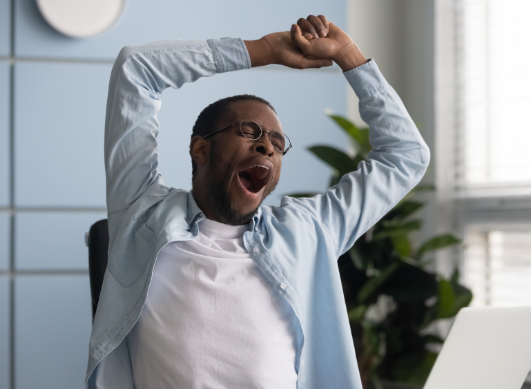Sleep apnoea and daytime fatigue: How can you boost your energy?
Published 24 Feb 2025 • By Somya Pokharna
Do you have obstructive sleep apnoea and wake up exhausted even after a full night’s sleep? If so, you’re not alone. Studies show that up to 70% of sleep apnoea patients experience persistent fatigue, even when using CPAP therapy. This fatigue is more than just feeling tired, it affects memory, mood, and daily functioning, making work and social activities more difficult.
So why does fatigue persist, even with treatment? And what can be done to regain energy?
Let’s explore the causes, treatments, and management approaches in this article to help you feel more rested and energized.

What causes chronic fatigue in sleep apnoea patients?
Obstructive sleep apnoea (OSA) causes repeated breathing interruptions throughout the night, preventing deep, restorative sleep. Even if you sleep for eight hours, your body may not get the rest it needs.
Here are some of the main reasons why fatigue persists:
- Sleep fragmentation: Frequent micro-awakenings caused by low oxygen levels prevent the body from reaching deep sleep stages (REM and slow-wave sleep).
- Inflammation and hormone imbalance: OSA increases levels of cortisol (the stress hormone) while reducing melatonin, making it harder to feel refreshed in the morning.
- Daytime oxygen deprivation: Poor oxygenation during sleep affects brain function and energy levels throughout the day.
- Coexisting conditions: Depression, anxiety, fibromyalgia, and chronic fatigue syndrome (CFS/ME) are more common in OSA patients, contributing to persistent fatigue.
How can sleep apnoea treatment reduce fatigue?
For most sleep apnoea patients, CPAP therapy (continuous positive airway pressure) is the first-line treatment. It keeps the airway open, allowing for uninterrupted breathing during sleep. However, many patients still feel fatigued even after starting CPAP.
One of the reasons behind this is poor CPAP adherence. Many patients struggle with discomfort, air leaks, or incorrect pressure settings. Conditions like restless legs syndrome (RLS) or insomnia can also interfere with sleep even when apnoea is treated, leading to residual sleep disturbances. Lastly, it can take several weeks or months for energy levels to improve after starting CPAP.
Other treatments for sleep apnoea include oral appliances, which are custom-made devices that reposition the jaw to keep the airway open (helpful for mild to moderate OSA).
In cases where CPAP isn’t effective, surgical procedures like UPPP (uvulopalatopharyngoplasty) or Inspire therapy (a surgically implanted nerve stimulator) may be considered.
While CPAP is highly effective, addressing other lifestyle and health factors is key to fully restoring energy.
What lifestyle changes and complementary therapies can help manage fatigue?
Improving overall sleep quality and daytime energy levels requires more than just CPAP therapy:
Improve sleep hygiene
Stick to a consistent sleep schedule, even on weekends. Avoid blue light (phones, tablets, TVs) at least an hour before bed. Keep your bedroom cool, dark, and quiet for optimal sleep conditions.
Exercise regularly
Moderate aerobic exercise (like walking, swimming, or cycling) can boost energy and improve sleep quality. Strength training may also help by improving oxygen utilization and reducing inflammation. However, avoid intense workouts close to bedtime, as they may interfere with sleep.
Eat for energy
Anti-inflammatory foods like leafy greens, fatty fish, nuts, and whole grains can reduce inflammation linked to OSA. Limit alcohol and heavy meals before bed, as they can disrupt sleep quality. Stay hydrated. Dehydration worsens fatigue and can make CPAP therapy feel more uncomfortable.
Cognitive behavioural therapy for insomnia (CBT-I)
Many sleep apnoea patients also struggle with insomnia, which CBT-I can help address. CBT-I helps break bad sleep habits and teaches relaxation techniques to improve sleep quality.
Mindfulness and relaxation techniques
Deep breathing exercises, progressive muscle relaxation, and meditation can reduce stress and promote better sleep. Yoga and tai chi may also be beneficial in improving overall sleep quality and energy levels.
Supplements and vitamins
Certain deficiencies may contribute to fatigue in OSA patients:
- Vitamin D – Low levels are linked to fatigue and poor sleep.
- Magnesium – Helps with muscle relaxation and deep sleep.
- Iron – Essential for oxygen transport; low levels can cause excessive fatigue.
- Melatonin – While not a cure for OSA, it may help regulate the sleep cycle in some patients.
Always consult your doctor before starting any supplements to ensure they are safe and appropriate for your health condition.
When should you see a doctor about persistent fatigue?
If you’ve addressed sleep apnoea but still struggle with fatigue, it’s important to rule out other underlying conditions.
Some signs that fatigue may have another cause are:
- Anaemia – Low iron or vitamin B12 levels can cause extreme tiredness.
- Thyroid disorders – Hypothyroidism often leads to chronic fatigue.
- Diabetes – Blood sugar imbalances can affect energy levels.
If lifestyle changes and CPAP aren’t enough, certain medications may help with excessive daytime sleepiness (EDS). Modafinil or armodafinil are stimulants that promote wakefulness. Solriamfetol is a newer medication approved for treating sleep apnoea-related fatigue.
If persistent fatigue is affecting your quality of life, speak with your doctor about possible solutions.
Did you find this article helpful?
Give it a “Like” and share your thoughts and questions with the community in the comments below!
Take care!
Sources:
Chervin, R. D. (2000). Sleepiness, fatigue, tiredness, and lack of energy in obstructive sleep apnea. Chest, 118(2), 372-379.
Chotinaiwattarakul, W., O'Brien, L. M., Fan, L., & Chervin, R. D. (2009). Fatigue, tiredness, and lack of energy improve with treatment for OSA. Journal of clinical sleep medicine : JCSM : official publication of the American Academy of Sleep Medicine, 5(3), 222–227.
Kim, S. A., Koo, B. B., Kim, D. E., Hwangbo, Y., & Yang, K. I. (2017). Factors affecting fatigue severity in patients with obstructive sleep apnea. The clinical respiratory journal, 11(6), 1045-1051.
Lal, C., Weaver, T. E., Bae, C. J., & Strohl, K. P. (2021). Excessive Daytime Sleepiness in Obstructive Sleep Apnea. Mechanisms and Clinical Management. Annals of the American Thoracic Society, 18(5), 757–768.
Mills, P. J., Kim, J. H., Bardwell, W., Hong, S., & Dimsdale, J. E. (2008). Predictors of fatigue in obstructive sleep apnea. Sleep and Breathing, 12, 397-399.
Mou, J., Zhou, H., Huang, S., & Feng, Z. (2024). The impact of comprehensive healthy lifestyles on obstructive sleep apnea and the mediating role of BMI: insights from NHANES 2005–2008 and 2015–2018. BMC Pulmonary Medicine, 24(1), 1-13.
Strollo Jr, P. J., & Rogers, R. M. (1996). Obstructive sleep apnea. New England Journal of Medicine, 334(2), 99-104.
Comments
You will also like

Fighting schizophrenia symptoms: a long journey against paranoia after detainment and denial
12 Dec 2018 • 7 comments

 Facebook
Facebook Twitter
Twitter

